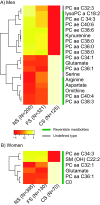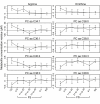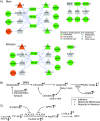Effects of smoking and smoking cessation on human serum metabolite profile: results from the KORA cohort study
- PMID: 23497222
- PMCID: PMC3653729
- DOI: 10.1186/1741-7015-11-60
Effects of smoking and smoking cessation on human serum metabolite profile: results from the KORA cohort study
Abstract
Background: Metabolomics helps to identify links between environmental exposures and intermediate biomarkers of disturbed pathways. We previously reported variations in phosphatidylcholines in male smokers compared with non-smokers in a cross-sectional pilot study with a small sample size, but knowledge of the reversibility of smoking effects on metabolite profiles is limited. Here, we extend our metabolomics study with a large prospective study including female smokers and quitters.
Methods: Using targeted metabolomics approach, we quantified 140 metabolite concentrations for 1,241 fasting serum samples in the population-based Cooperative Health Research in the Region of Augsburg (KORA) human cohort at two time points: baseline survey conducted between 1999 and 2001 and follow-up after seven years. Metabolite profiles were compared among groups of current smokers, former smokers and never smokers, and were further assessed for their reversibility after smoking cessation. Changes in metabolite concentrations from baseline to the follow-up were investigated in a longitudinal analysis comparing current smokers, never smokers and smoking quitters, who were current smokers at baseline but former smokers by the time of follow-up. In addition, we constructed protein-metabolite networks with smoking-related genes and metabolites.
Results: We identified 21 smoking-related metabolites in the baseline investigation (18 in men and six in women, with three overlaps) enriched in amino acid and lipid pathways, which were significantly different between current smokers and never smokers. Moreover, 19 out of the 21 metabolites were found to be reversible in former smokers. In the follow-up study, 13 reversible metabolites in men were measured, of which 10 were confirmed to be reversible in male quitters. Protein-metabolite networks are proposed to explain the consistent reversibility of smoking effects on metabolites.
Conclusions: We showed that smoking-related changes in human serum metabolites are reversible after smoking cessation, consistent with the known cardiovascular risk reduction. The metabolites identified may serve as potential biomarkers to evaluate the status of smoking cessation and characterize smoking-related diseases.
Figures






References
-
- Wang-Sattler R, Yu Y, Mittelstrass K, Lattka E, Altmaier E, Gieger C, Ladwig KH, Dahmen N, Weinberger KM, Hao P, Liu L, Li Y, Wichmann H-E, Adamski J, Suhre K, Illig T. Metabolic profiling reveals distinct variations linked to nicotine consumption in humans--first results from the KORA study. PLoS One. 2008;3:e3863. doi: 10.1371/journal.pone.0003863. - DOI - PMC - PubMed
-
- Xavier F, Henn L de A, Oliveira M, Orlandine L. Smoking and its relation to the histological type, survival, and prognosis among patients with primary lung cancer. Sao Paulo Med J. 1996;114:1298–1302. - PubMed
-
- Smoking-attributable mortality, years of potential life lost, and productivity losses--United States, 2000-2004. Morbidity and Mortality Weekly Report. 2008;57:1226–1228. - PubMed
-
- Bøttcher M, Falk E. Pathology of the coronary arteries in smokers and non-smokers. J Cardiovasc Risk. 1999;6:299–302. - PubMed
Publication types
MeSH terms
LinkOut - more resources
Full Text Sources
Other Literature Sources
Medical

